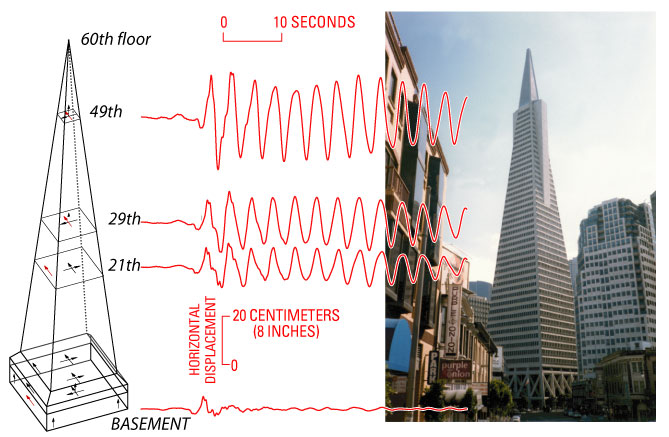
The 1989 Loma Prieta earthquake (magnitude 6.9) set San Francisco’s Transamerica Pyramid swaying and rocking. An array of 22 sensors (small arrows) recorded horizontal movement on the 49th floor of the building five times greater than the 1.5 inches measured in the basement, as indicated by the recordings (red lines).
Learn more: USGS Fact Sheet 068-03 Monitoring Earthquake Shaking in Buildings to Reduce Loss of Life and Property.
Strong-motion recordings of damaging earthquakes in densely urbanized areas are critical for designing earthquake-resistant structures to reduce property loss and casualties from future earthquakes. The recordings also are fundamental for understanding and characterizing the physics of earthquake rupture, the generation and propagation of damaging ground motions, and the shaking performance of structures.
The USGS National Strong-Motion Project (formerly titled the National Strong Motion Program) has the primary Federal responsibility for acquiring strong motion records of significant earthquakes in the United States recorded by sensors placed in the ground and in man-made structures.
Currently the NSMP operates and maintains strong-motion instruments at more than 660 ground, free-field and reference sites, and more than 3200 channels of data from about 180 structural arrays. When a significant earthquake occurs, the NSMP automatically retrieves strong motion recordings from its instrumentation as well as from more than 2000 other instruments operated throughout the US by federal, state, and local agencies, private companies, and academic institutions that participate in the Advanced National Seismic System (ANSS). The NSMP rapidly processes these recordings according to COSMOS standards and archives the products at the Center for Engineering Strong Motion Data.
For questions about data, metadata, and station operations, please send email to: nsmp@usgs.gov.
 Jump to Navigation
Jump to Navigation